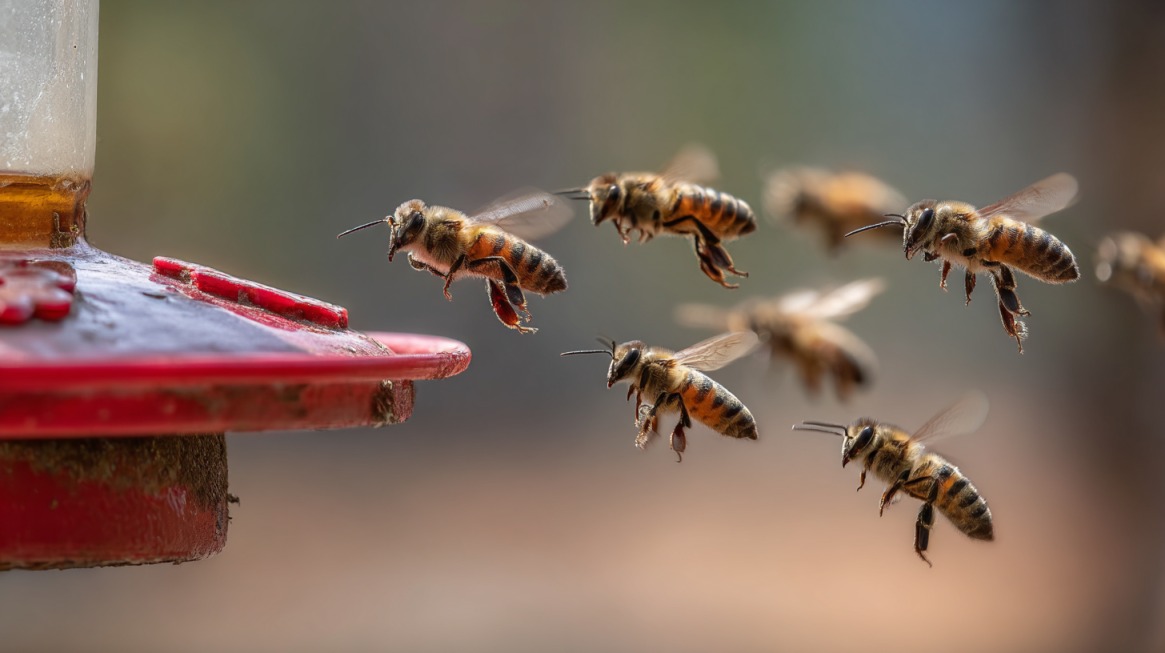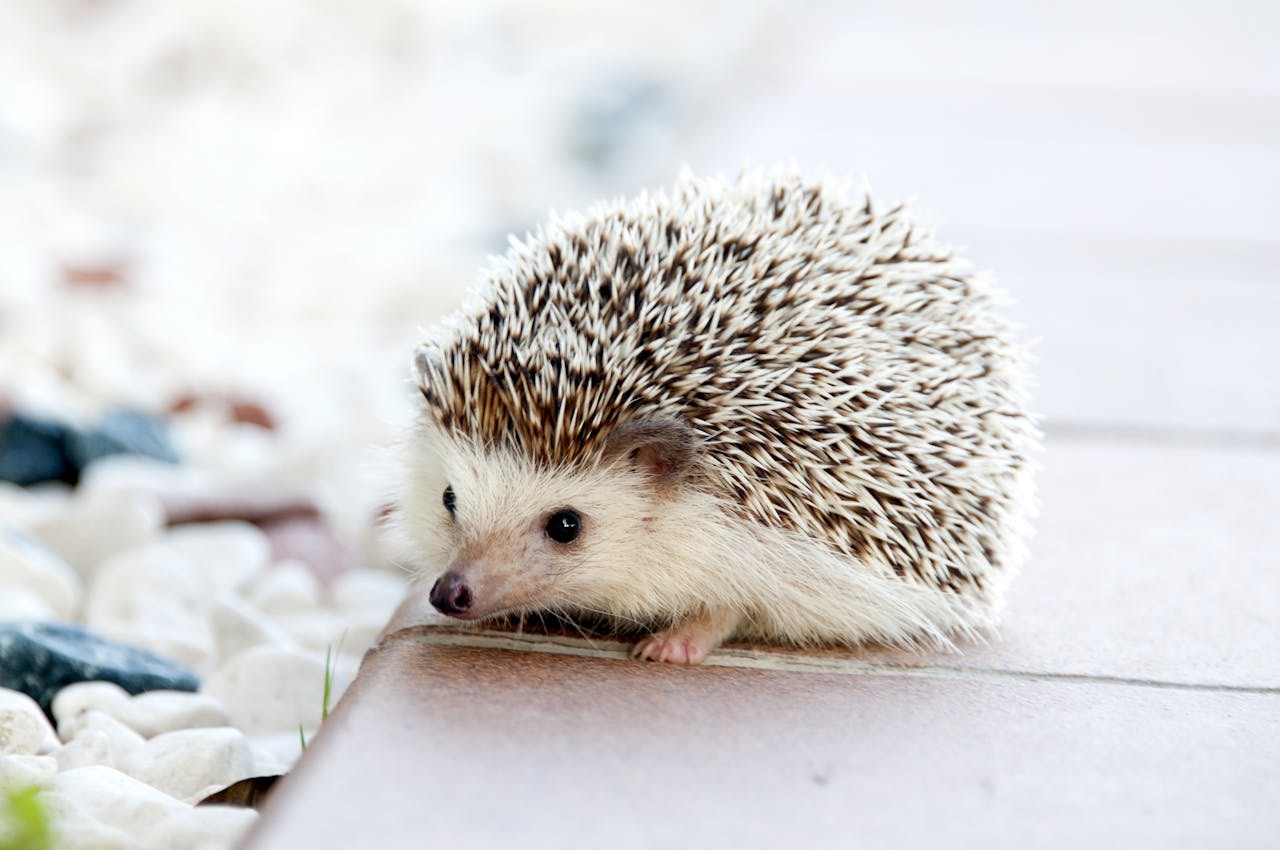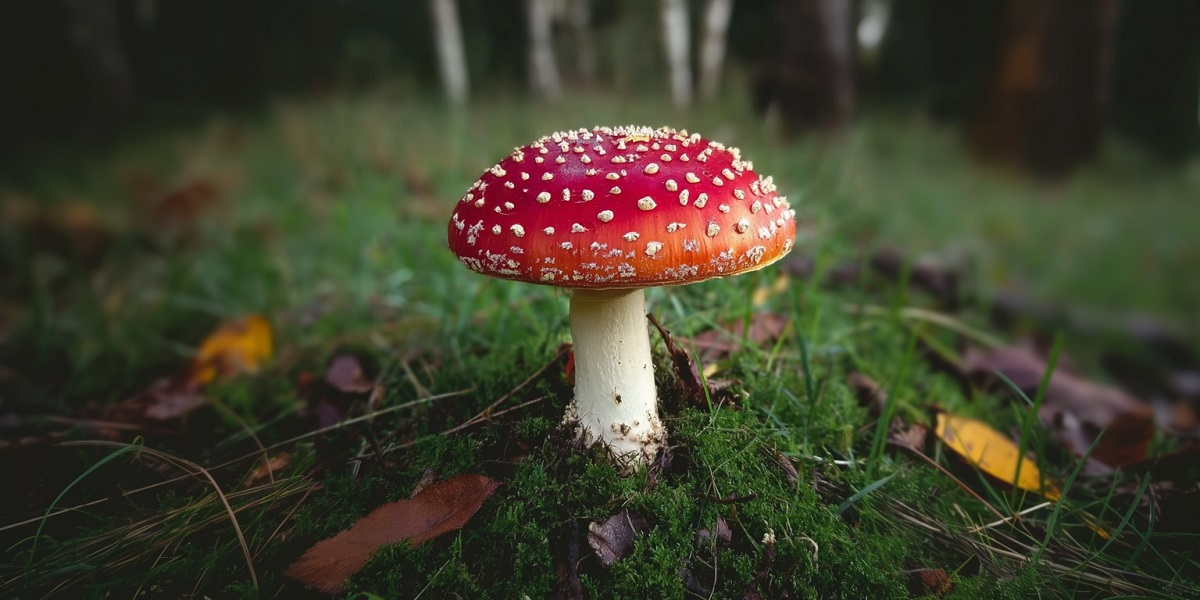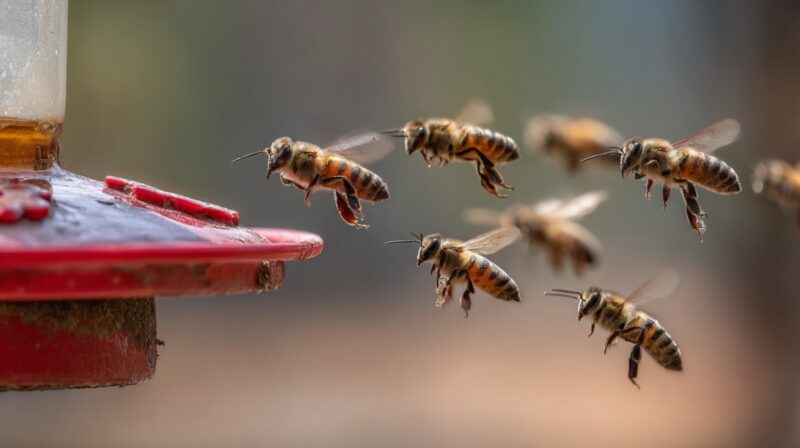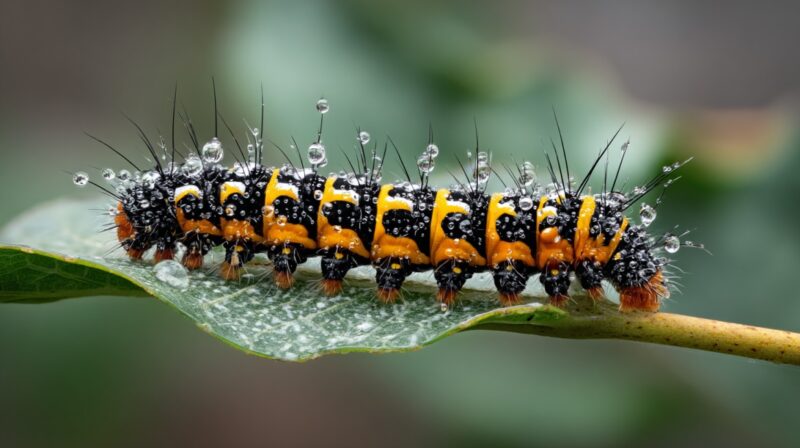
Share Post:
Soft, fluffy, and colorful caterpillars can easily fool anyone into thinking they are harmless.
Yet some of them hide an arsenal of venomous defenses beneath those inviting hairs and tufts.
Many of these caterpillars inject venom through hollow spines, causing painful and sometimes dangerous reactions.
Observing them from a distance is the safest choice. A single touch on the wrong species can result in burning pain, swelling, or worse.
| Caterpillar Name | Appearance | Danger | Habitat |
|---|---|---|---|
| Puss Caterpillar (Megalopyge opercularis) | Fuzzy, wig-like appearance; soft fur concealing spines | Venomous spines under fur cause intense pain | Southeastern U.S. (Florida, Texas); prefers oak, citrus, elm trees |
| Saddleback Caterpillar (Acharia stimulea) | Bright green saddle on brown body with sharp spines | Venom-injecting spines | Eastern & Southern U.S.; gardens, shrubs, forests |
| Io Moth Caterpillar (Automeris io) | Green with rows of black-tipped spines | Spines release venom on skin contact | Canada to Mexico; Eastern North America |
| Assassin Caterpillar (Lonomia obliqua) | Dull green or brown with dense spines | One of the most venomous; disrupts blood clotting | South America (especially Brazil); humid forests |
| Hag Moth Caterpillar (Monkey Slug) (Phobetron pithecium) | Hairy, irregular, tarantula-like | Detachable stinging hairs with mild venom | Eastern U.S.; shaded vegetation and trees |
| Buck Moth Caterpillar (Hemileuca maia) | Large, dark, spiny body | Venomous bristles cause severe pain; remain active even after death | Southeastern U.S.; oak forests |
| Stinging Rose Caterpillar (Parasa indetermina) | Neon red or yellow with jagged spines | Venomous spines deliver toxins | Eastern U.S.; forests, rose bushes, maples |
| White-Marked Tussock Moth Caterpillar (Orgyia leucostigma) | White tufts, red dots, black bristles | Urticating hairs trigger allergic reactions | North America; common on patios, fences, and outdoor furniture |
1. Puss Caterpillar (Megalopyge opercularis)
A creature that resembles a fuzzy ball of fur or a soft wig might seem like something to pet, but doing so could become an unforgettable mistake. Hidden beneath its silky coat lie venomous spines capable of delivering excruciating pain.
People who have been stung describe the sensation as an intense burning that can spread through the body, often compared to a severe burn or broken bone.
Once the venom enters the skin, the pain can last for hours, accompanied by a variety of symptoms that extend well beyond a simple sting.
- Intense burning and radiating pain
- Rash that spreads across the affected area
- Nausea and vomiting caused by a systemic reaction
- Swollen lymph nodes and general weakness
@oddanny The most dangerous caterpillar in the U.S. 👀 #pusscaterpillar ♬ original sound – Odd Danny
Found primarily in the southeastern United States, especially in Florida and Texas, this caterpillar prefers warm, wooded environments where oak, citrus, and elm trees thrive. Its camouflage among leaves makes it easy to mistake for plant fuzz or debris.
Many encounters occur when people accidentally brush against it while gardening or collecting firewood.
Wearing gloves and long sleeves when working near potential habitats is an effective precaution. Its fuzzy coat may look soft, but every hair is a potential needle filled with venom.
- Range: Southeastern U.S. (Florida and Texas)
- Symptoms: Burning pain, rash, nausea, vomiting
2. Saddleback Caterpillar (Acharia stimulea)
Vivid coloration makes this small caterpillar one of the most visually striking species in North America.
Bright green patches form a saddle-shaped mark on its back, contrasted by a dark brown body covered in sharp spines.
The bright colors act as a warning to predators and people alike.
Those curious enough to touch it quickly learn how effective its defense mechanism can be. Its spines penetrate the skin and inject venom almost instantly.
- Sharp, stabbing pain on contact
- Swelling around the affected area
- Hives and red welts developing within minutes
- In severe cases, dizziness or difficulty breathing due to an allergic response
Inhabiting gardens, shrubs, and forests across the eastern and southern United States, the saddleback caterpillar feeds on a variety of plants, including:
- Corn
- Roses
- Fruit trees
Its bright pattern and compact shape make it easy to overlook while pruning leaves or harvesting fruit.
Those who spend time in the garden should remain alert for its vivid saddle marking, which acts as nature’s warning sign.
- Range: Eastern and southern U.S.
- Symptoms: Pain, swelling, hives, potential anaphylaxis
3. Io Moth Caterpillar (Automeris io)
Green coloration decorated with rows of black-tipped spines gives the Io Moth caterpillar a striking look that is impossible to ignore.
Found across much of North America, this species is often spotted in groups feeding on tree leaves.
- Intense burning followed by itching
- Raised welts resembling nettle burns
- Prolonged irritation that may last several hours
- Red patches forming where spines penetrate the skin
Populations extend from southern Canada through the eastern United States and down to Mexico. These caterpillars frequently appear in clusters, so brushing against one leaf can result in multiple stings at once.
Outdoor enthusiasts and gardeners should take care when handling branches or leaves, as these larvae often blend with their surroundings.
Admiring their beauty is best done at a safe distance to avoid painful consequences.
- Range: Canada to Mexico, Eastern North America
- Symptoms: Burning, welts, prolonged itching
4. Assassin Caterpillar (Lonomia obliqua)
Deadly yet deceptively ordinary in appearance, the assassin caterpillar has earned its reputation as one of the most venomous insects on Earth.
Dull green or brown coloring allows it to hide easily on tree bark or foliage, but its spines contain a toxin capable of disrupting the body’s ability to clot blood.
Even minor contact can result in life-threatening symptoms.
- Severe internal bleeding and bruising
- Hemorrhaging from minor cuts
- Kidney failure due to toxin absorption
- Dizziness, headache, and muscle pain before collapse
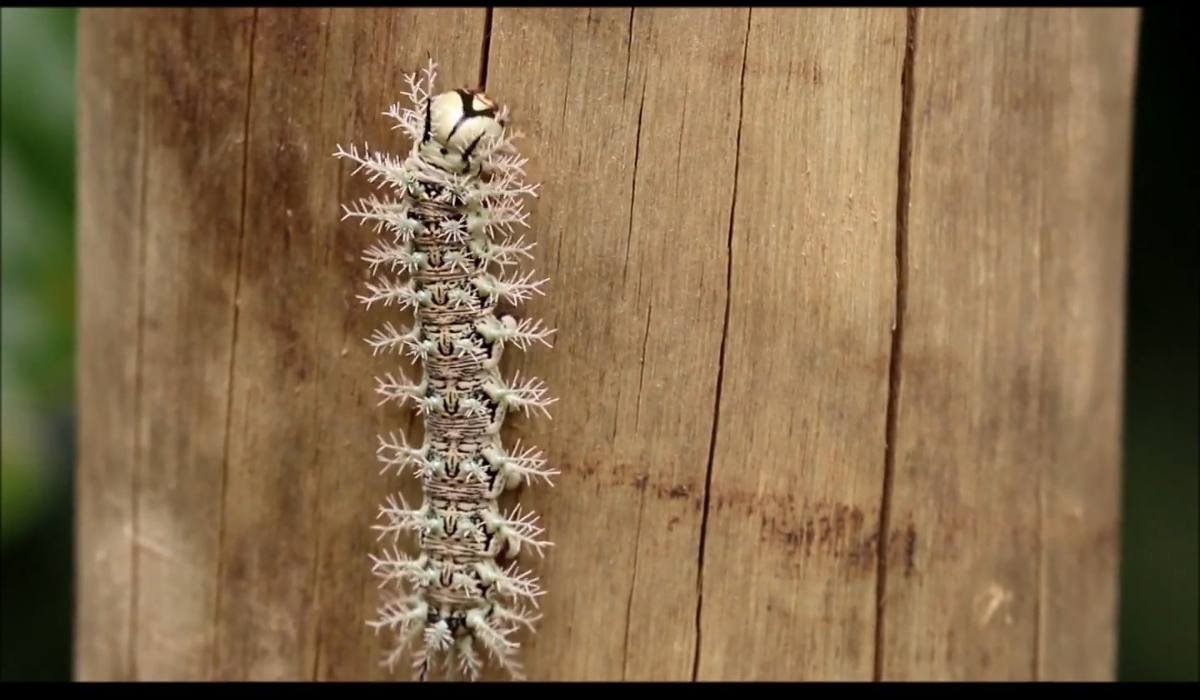
Found mostly in Brazil and surrounding South American countries, it inhabits humid forests and rural areas. Several recorded deaths have been attributed to contact with large groups of these caterpillars.
During certain months, outbreaks prompt local authorities to issue warnings urging residents to avoid brushing against tree trunks.
Wearing protective clothing and avoiding unknown caterpillars are vital precautions for those traveling through affected areas.
@oddanny The most dangerous caterpillar in the world 👀 #lonomiaobliqua ♬ original sound – Odd Danny
- Range: South America, especially Brazil
- Symptoms: Internal bleeding, kidney failure, risk of death
5. Hag Moth Caterpillar (Phobetron pithecium) – “Monkey Slug”
Few caterpillars look as strange as the hag moth, commonly called the monkey slug.
With its bizarre, hairy projections and uneven shape, it resembles a small tarantula or a clump of moss. This odd disguise helps it avoid predators while hiding detachable stinging hairs that can cause discomfort.
When those hairs embed in the skin, mild venom produces itching and irritation that can last for several hours.
- Itching and redness at the sting site
- Localized swelling or rash
- Moderate discomfort, rarely severe pain
Found throughout the eastern United States, it prefers shaded areas with dense vegetation.
Trees such as oak, cherry, and dogwood provide ideal shelter. People often mistake it for debris and accidentally touch it while clearing brush or picking leaves.
Observing it from afar is safer, as touching even once can lead to an itchy reminder of nature’s defenses.
- Range: Eastern U.S.
- Symptoms: Itching, rash, mild to moderate pain
6. Buck Moth Caterpillar (Hemileuca maia)
Large, dark, and covered with spines, the buck moth caterpillar has earned a reputation for inflicting severe pain.
Its venom-bearing bristles release toxins that cause immediate burning and swelling. Even contact with a dead caterpillar can result in stings, since the venom remains active within the spines.
Encountering a cluster amplifies the pain due to multiple punctures at once.
- Sharp, radiating pain lasting several hours
- Red, swollen welts that take days to fade
- Itching or blistering around the affected skin
- Sensitivity to touch long after initial contact
Commonly found in oak forests of the southeastern United States, these caterpillars appear during late spring and summer.
They frequently crawl across hiking trails and tree trunks, making accidental contact a real risk.
Wearing long clothing and avoiding direct handling of tree bark in oak areas can help reduce encounters.
- Range: Southeastern U.S., oak forests
- Symptoms: Intense pain, swelling, lingering welts
7. Stinging Rose Caterpillar (Parasa indetermina)
Brilliant colors and jagged spines make the stinging rose caterpillar both beautiful and dangerous.
Neon yellow or bright red markings act as nature’s warning sign, signaling that contact will not end pleasantly. Its venomous spines inject toxins that cause prolonged irritation and swelling on the skin.
Found mostly in forested regions across the eastern United States, it feeds on rose bushes, maples, and fruit trees.
- Sharp sting followed by redness
- Swelling around the contact site
- Persistent itching and irritation lasting for hours
- Sensitivity to touch days after exposure
The caterpillar’s vibrant body serves as a deterrent to predators but often draws human curiosity.
Gardeners trimming roses or collecting leaves should stay alert for its distinctive colors. Touching even once is enough to turn fascination into pain.
- Range: Forested areas in the Eastern U.S.
- Symptoms: Redness, swelling, prolonged irritation
8. White-Marked Tussock Moth Caterpillar (Orgyia leucostigma)
Bright tufts of white hair and rows of red dots give this caterpillar an unmistakable look.
Black bristles project outward, ready to release irritating hairs at the slightest touch.
Its urticating setae trigger allergic reactions and rashes that can appear hours later, especially in people with sensitive skin.
Though not deadly, the discomfort it causes can last for days.
- Rash or hives forming several hours after contact
- Persistent itching and irritation
- Red spots or small welts on the arms and hands
Distributed widely across North America, this species often appears in late summer when it wanders across patios, fences, or outdoor furniture.
Its bright pattern makes it stand out, yet curiosity should never lead to handling. Protective gloves and caution can prevent an unpleasant allergic reaction.
- Range: North America
- Symptoms: Rash, itching, delayed discomfort
Summary
Colorful caterpillars often attract attention with their adorable looks, yet several hide potent defenses and can be quite terrifying (just like deep-sea creatures are, check out our list of the scariest ones!).
Venomous hairs and spines can inflict extreme discomfort or even medical emergencies. Safe observation practices, no touching, no handling, should always apply.
When contact does occur, prompt medical care becomes vital, especially if pain or swelling worsens. Admiring their beauty from afar ensures safety while appreciating nature’s deceptive artistry.
Related Posts:
- 10 Rare Albino Animals You’ve Probably Never Seen Before
- What Do Caterpillars Eat? A Guide to Their Diet
- Top 10 Migratory Birds in The World You Need to Know About
- Top 15 Small Parrot Species You Can Keep as Pets
- Inside a Penguin Mouth - Not What You’d Expect
- How Fast Can an Ostrich Run? Everything You Need to Know




